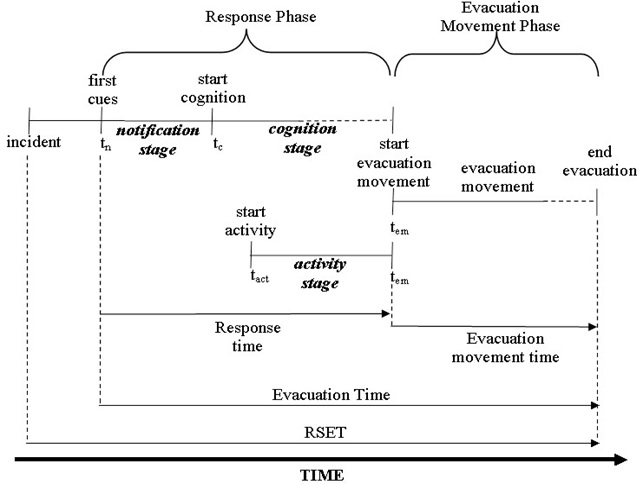Human behavior in evacuation
Human behavior in evacuation
How people behave during an escape is referred as evacuation behavior. Lots of scholars have tried to develop a comprehensive and integrative model of human behavior in evacuation from buildings (Gershon et al., 2007; Kobes et al., 2010; Kuligowski, 2008) and most of them have concentrated their attention on the individual actor, taking into account issues like individual threat perception, individual decision making in crisis (Aguirre, 2005).
Another characteristic of this type of studies is that they usually concern evacuation in case of fire (Aubé & Shield, 2004; Benthorn & Frantzich, 1996; Graham & Roberts, 2000). A possible explanation is that fires occur more often than other disasters like earthquakes or hurricanes and that they don’t depend on any geographical position. So they are more common. As will explained later on, the type of hazard can change the behavioral response, but lots of findings can be applied to different situations of evacuation. In this literature review we will present two recent different behavioral models for evacuation, one presented by Kuligowski (2008) and the other one developed by Galea, Dreere, Sharp, Filippidis and Hulse (2010). They are not in contrast with one another, but they only differ regarding the terms used and some details. Kuligowski (2008) suggests an interesting conceptual model of the behavioral process for evacuation from building fires consisting of 4 phases:

Figure 1 – Kuligowski’s evacuation process
-
- perception of the cue/s – this phase involves occupants receiving cue/s (which can be physical or social) that makes them aware that something in their environment has changed. This step is usually characterized by uncertainty, misunderstanding and inefficiency. The degree of uncertainty regarding the danger of the situation delays the beginning of the evacuation (Kobes et al., 2010). At first occupants get information about the change in the situation. This can be done by direct observation, such as smelling smoke or perceiving the building’s shaking, or by indirect information, like a fire alarm (Benthorn & Frantzich, 1996).
-
- interpretation of the cue/s, situation and risk – occupants attempt to organize the perceived cue/s into a framework to construct a meaningful story based on it and to make sense of the situation by imagining what is happening. The interpretation of the cue is not always rational. Indeed, there is a persistent and strong normalcy bias that emerge in this stage, in which occupants misunderstand the cue and interpret it as a normal feature of daily routine (Aguirre, 2005). Is crucial to nullify this bias for occupants to start the evacuation. Moreover, it has to be taken into account that cues are interpreted differently in different buildings (Benthorn & Frantzich, 1996). For example, smoke in a restaurant kitchen is not interpreted as an evidence of fire but as a normal occurrence;
-
- decision making – at first, occupants look for options about what to do, by performing mental simulation, and then choose one of them. This phase is influenced by time pressure that stresses occupants and limits their mental resources in choosing the best option. Usually, when occupants become aware of the situation, the arousal level increase, but it shouldn’t be neither too high or too low. If it gets too high, the tendency of stop thinking and acting in panic rises. If it gets too high, occupants might ignore the danger (Benthron & Frantzich, 1996).
-
- action – occupants perform some types of physical act, which can be evacuating but also waiting, seeking information, alerting or assisting others or preparing for evacuation. One element of this phase is way-finding. “Way-finding, within the building evacuation context, describes the process by which an individual located within an unfamiliar and arbitrarily complex enclosure attempts to find a path which takes them to a place of relative safety or at an exit leading them to the exterior of the enclosure” (Xie, Filippidis, Galea, Blackshields & Lawrence, 2009, p. 289). According to Arthur and Passini (1992), way-finding is a cognitive process composed of the following abilities: a cognitive-mapping or information generating ability, a decision-making ability and a decision executing ability. The first is needed to understand the environment, the second to decide what to do and the third one to effectively perform the action choose. This formalization implies also the possibility to modify the plan while the process is going on, for example in case of unforeseen. Other authors have considered the way-finding as composed of different stages. Downs and Stea (1973), for example, propose to divide the way-finding process in: spatial orientation, the selection of the initial route from the starting point to the target (for example the exit door), continuous monitoring of the route taken and the ability to recognize when the target has actually been achieved. Research on way-finding has found out that people use specific criteria to choose the path to follow. Some of them are the same in all the different environments, others not. For example, shortest distance or fewest turns are important factors both in outside and in inside environment. On the other hand, most scenic/aesthetic route and first noticed route are criteria only used in case of urban based way-finding (Golledge, 1995). According to Kuligowski (2008) on 30 evacuation models reviewed, only 2 included some wayfinding features. This neglect results in less realism of the evacuation models, because they assume that all the individuals know exactly all the features of the environment in which they are. “The introduction of way-finding into evacuation simulation potentially overcomes the problem of unrealistic evacuation dynamics by generating more complex existing behaviors with resulting added complexity in occupant flow dynamics” (Veeraswamy, Lawrence & Galea, 2009, p. 511).
Galea, Dreere, Sharp, Filippidis and Hulse (2010) consider the first 3 elements presented by Kuligowski (2008) in the same phase, called response phase, separated from the evacuation movement phase (see Figure 2).
The response phase is comprised of 3 stages: notification, cognition and activity. The notification stage is similar to what Kuligowski (2008) calls the perception of the cue phase. Indeed, in this step, a cue conveys to the occupants that an unusual and potentially dangerous event is occurring and that they have to evacuate. The notification stage ends with the beginning of the cognition stage, which is analogous to the interpretation of the cue and decision making phases. Nevertheless, Galea and colleagues (2010) specify three different types of decisions about how to react:
-
- the cue is not enough strong or clear to convey to the occupants the immediate need to evacuate, so they come back doing what they were engaged to do. In this case, the cognition stage continues until one of the other two possible responses occur;
-
- the occupants understand the need to evacuate. They stop with other tasks and start evacuation movements without undertaking any other activity;
-
- the occupants recognize that the notification cues indicate that something potentially dangerous is occurring in their environment and as a result undertake a series of Action and/or Information Tasks.
If occupants decide to react following the third point, the activity stage starts. This phase could occur in parallel with the cognition stage and they can affect each other: activities leading to new cognitions and vice versa. So occupants can go and come back between these two stages, they can return to the cognition stage to understand new developments of the situation or interpret new information and change the next course of actions planned. During the activity stage, occupants perform the Action Tasks or the Information Tasks that have developed during the cognition stage. Some examples of Action Tasks can be: shutting down a work station, packing work items, packing/collecting personal belongings in the immediate vicinity, physically moving to another location to perform an action (e.g. fight fire, collect an item). With Information Tasks Galea and colleagues (2010) mean seeking, providing or exchanging information concerning the incident or required course of action and may include, calling someone on the phone to seek or provide information, seeking or providing information in person, engaging with electronic media (e.g. television, radio, text services, etc), investigating the incident. The activity stage starts with the beginning of the planned tasks and ends with their conclusion. The end of the activity stage also marks the conclusion of the response phase and the successive beginning of the evacuation movement phase.

Figure 2 Retreived from Galea et al., 2010
The response phase involves several behavioral aspects like the perception of the incident, the perception of the seriousness of the incident, the disengagement of the person from what he/she was doing, the collection of goods and the investigation of the incident before leaving the building (Gwynne, Galea, Parke & Hickson, 2003).
This response phase produces a delay time in beginning the evacuation process. It can go from a few seconds to some minutes and sometimes the pre-evacuation time is even greater than the actual time needed to evacuate (Gwynne et al., 2003). Predicting this delay is essential to be able to calculate realistic evacuation times. The delay varies according to the type of the alarm system in place, the time of the day, the presence of additional cues that can support the evacuation like instructions or smoke (Gwynne et al., 2003). Moreover, the response delay varies also according to the characteristics of the occupants, the hazard safety features and the type of occupancy (Proulx & Fahy, 1997). Indeed, office and residential buildings are diverse environments and have different characteristics. Differently from residential occupancies, in offices people are usually not responsible for others like children, elderly people or family members in general that need assistance. Working people are capable adults that don’t have to take care of other people and when the emergency alarm rings, they can suddenly start rescuing themselves. Another feature of office buildings is that people are usually awake, dressed and active. For this reason the time needed to start the evacuation is lower. They don’t need to wake up or to get dressed, activities that are more usual if people are resting at home. Moreover, people working in office buildings are usually trained for emergencies. Most of the times they know emergency procedures and regularly receive trainings or do drills, while occupants of residential occupancies don’t. Finally, people working need less time to interpret the cue and understand that is time to evacuate because in the office environment usually it is possible to rapidly observe others and interact with colleagues about how to face the emergency (Proulx & Fahy, 1997).
During the evacuation movement phase occupants perform the actions needed to exit the building. The most important element of this phase is the exit choice. Benthorn and Frantzich (1996) conducted an interesting experiment to test their Theory of Choice by Distance and Familiarity, revealing the preference for the normal exit instead of the emergency exit. This is due to the tendency to choose the known before the unknown, and in case of known routes the familiarity has more importance than the width or length. Moreover, the authors investigated the condition in which, instead, occupants chose the emergency exit: “if the distance to the normal exit was twice the distance to the emergency exit and if that exit was open almost all the persons chose that exit” (Benthorn & Frantzich, 1996, p. 5). What unexpectedly emerged from this study is that people are not aware of the reason of the exit choice, leading the authors to suppose that the decision process was on an unconscious level.
According to Frantzich (as cited by Kobes et al., 2010), the time needed for movement purposes is well documented, meaning that it is possible to measure the time needed to egress different types of buildings and occupants.
© – MANAGEMENT OF AN EMERGENCY EVACUATION: A LEADER’S PERSPECTIVE – Sara Colangeli

